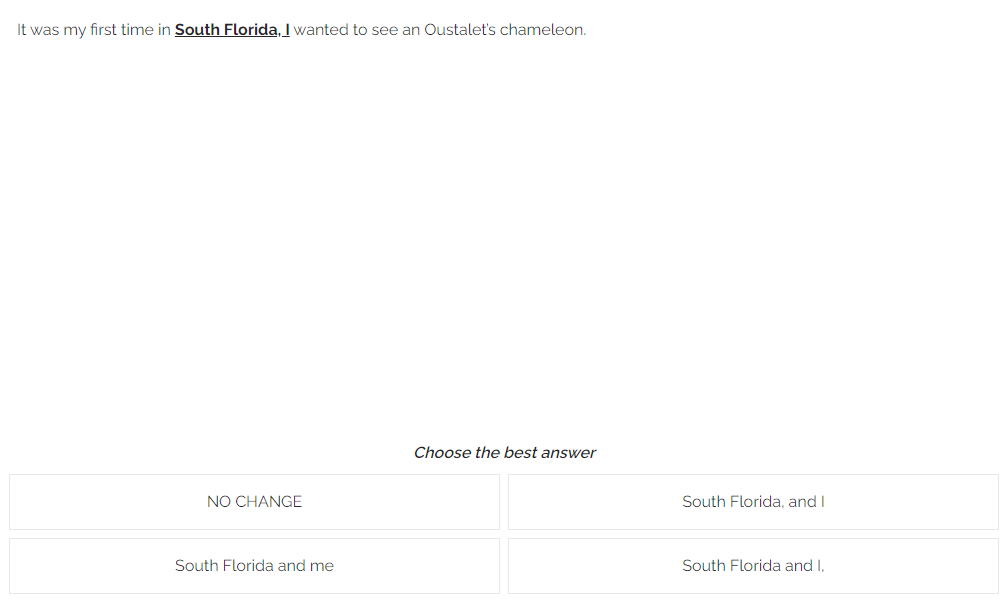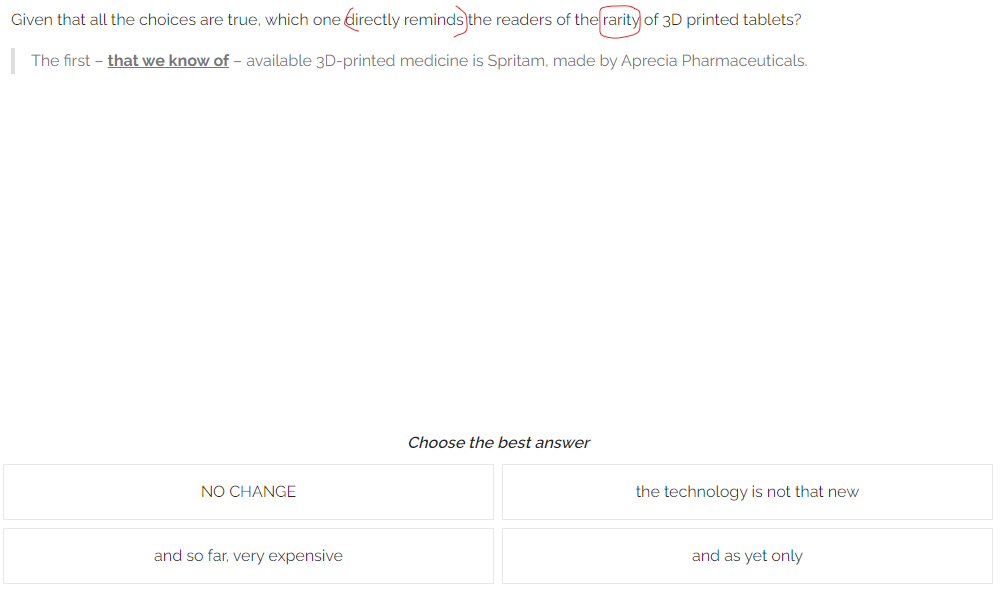Occasionally, the ACT will want you to know how the style of a paragraph affects its meaning. When we say “style,” think “vibe.” Consider the following sentences:
Style 1
The azure ocean above the earth clashed gloriously with the kaleidoscope of color against the horizon, embellishing the natural world with a dazzling celebration of the end of the day.
Style 2
The blues of the sky met the multicolored clouds of the horizon to create a beautiful sunset.
Both of these sentences are grammatically correct. Both of them communicate the same thing.
The only difference is the “vibe” or “feel” they’re giving off. We call this rhetorical style, or just “style.”
Take a look at Style 1 again.
The azure ocean above the earth clashed gloriously with the kaleidoscope of color against the horizon, embellishing the natural world with a dazzling celebration of the end of the day.
We can agree this is flowery and draws on figurative language and imagery.
Now let’s take another look at Style 2.
The blues of the sky met the multicolored clouds of the horizon to create a beautiful sunset.
This gets straight to the point. In some ways, it suggests an admiration of the beauty of the natural world as the first sentence does, but it’s a very different flavor of admiration.
Now, imagine you have a whole passage on the ACT written in Style 2, and it asks if the sentence from Style 1 would be a fitting replacement for an underlined sentence in the passage. Of course not! It would stick out and be weird.
Remember: A passage style should remain consistent throughout.
Also, remember that Style 1 and Style 2 as listed above are just examples. If we named them, Style 1 might be called “Flowery” or “Epic.” Style 2 might be named “Straightforward” or “Literal.” Here are some other examples of style that you may want to consider applying to different texts:
Authors pick whichever style they think will best get their message across. For our purposes with the ACT, we simply need to know that that style should remain consistent.
Consider the following passage.
In 2003, NASA’s Spitzer Space Telescope was launched from Cape Canaveral in Florida and sent into orbit around the Sun, trailing slightly behind the Earth but gradually drifting away from it. From this prime position, the telescope could easily study infrared radiation originating from sources many billions of light-years away, completely free from the influence of Earth’s atmosphere. In addition, the spacecraft was equipped with a supply of ultracold helium. When cooled to −271°C by the helium, Spitzer became well suited to studying wavelengths across the infrared range.
Dubbed “NASA’s Great Observatory for Infrared Astronomy,” the Spitzer Space Telescope was designed to investigate four major topics: the early universe, giant planets, and brown dwarfs, the planet-forming debris disks surrounding newly formed stars, and the extremely bright regions found at the centers of some galaxies. [A] The most important of these was an arrangement of four array detectors named the Infrared Array Camera (IRAC).
At Point [A], which of the following sentences would match the tone of the rest of the passage and accentuate technological progress as embodied by the telescope?
A. In order to accomplish this, the telescope was affixed with a triad of apparati.
B. To do this, the telescope was fitted with three cutting-edge instruments.
C. To solve these goals, the telescope had three special parts.
D. A triumvirate of whimsical contraptions gave the telescope the prowess to accomplish those goals.
Let’s break it down one answer choice at a time. Remember, we have two goals, according to the question: 1. Match the style of the paragraph and 2. Accentuate the technological progress demonstrated by the satellite.
Option A. This is an okay option, but not great. It sort of matches the style, but it goes a little too far. Note the wordiness of it: “triad of apparati”? Sounds like someone is trying to sound smart instead of communicating clearly. The rest of the article doesn’t use trumped-up language like this.
Option B. This seems like a really good option. Its basic, matter-of-fact tone does match the rest of the passage, and it uses the word “cutting-edge” to describe the instruments, thereby highlighting that this is new technology as the question wanted us to.
Option C. We don’t love this one because it seems too simplistic compared to the rest of the paragraph. There’s a fair amount of technical language used elsewhere, while this one doesn’t do anything to accentuate technical progress and uses low-level phrases like “special parts” and “solve these goals,” neither of which work well.
Option D. This option definitely highlights technical advances, but the style is way too over-the-top to match the rest of the passage. Phrases like “triumvirate of whimsical contraptions” and the use of “prowess” for “power” are much too flowery to be consistent with the rest of the passage’s matter-of-fact tone.
Do you know which answer is correct?
Answer: B. To do this, the telescope was fitted with three cutting-edge instruments.
The key to answering this question type correctly is comparing the style of the answers with the style of the passage. This takes time, but it works.
Here’s something we tell our tutoring students about these questions:
The difference between getting these questions right and wrong is about 15 seconds.
You see, most students who answer these questions incorrectly rush through them. This makes sense. After all, most questions on the English ACT don’t ask you anything, they just give you options.

As we see from the question above, there isn’t an actual “question.” We’re just given a few options to choose from.
Naturally, these shorter questions don’t take too long to answer. We just go straight to the options and start looking for the right answer.
Style questions are different. Take this one for example:

Do you see how there’s a lot more to unpack here than with the previous question?
On style questions, use this strategy and in this order:
We’ll be honest. These questions take longer than most ACT English questions. So be prepared to spend time on them.
For one thing, unless you have a photographic memory, you’ll need to read the question multiple times (2–3 times).
As you read, look for clues the question will give you. The clues are the specific words that tell us what to look for in the answers or the essay.
Now, we’re going to recommend you do something that you probably won’t want to do. Annotate the clues in the question.
Most students we work with hate annotating. We get it. It’s tedious, annoying, and not fun. But for these kinds of questions, it’s incredibly helpful. When you annotate, don’t use underlining. Instead, use noticeable annotations like circles, squares, brackets, or parentheses.
We’ve found that most students don’t pay attention to what they underline nearly as much as when they circle, square, or use a more noticeable annotation mark.
Here’s an example:

These clues marked in the image above will be our guide when we pick our answer.
If you don’t mark the clues, you’re more likely to forget what you’re looking for. If that happens, the ACT English will trick you into choosing an option that “sounds good” over an option that actually answers the question.
While other answers may sound prettier, more fun, eloquent, or better written, the choice that says “and as yet only” gives us what the question asked for. So, that’s what we’ll pick.
When we tutor students, we often get some resistance from them on this advice. They’re not used to annotating. They’ve done fine without it so far. So, why should they do it now?
Short answer: annotating helps organize your thoughts.
We would never ask our students to do more work for the sake of doing more work.
Some students resist annotating because they worry it will slow them down. This is a reasonable concern.
Remember though, this is the ACT, not your family Bible (or Quran, or Torah, or an autographed photo from your favorite celebrity). Get messy. Make your annotations quickly but strategically. You just want them to be noticeable, not perfect.
A scratchy, asymmetrical oval is just as effective as a perfect circle. Just do it and move on. It may take a bit more time, but you’ll nearly double your accuracy on these questions if you do so.
Sign up for free to take 8 quiz questions on this topic